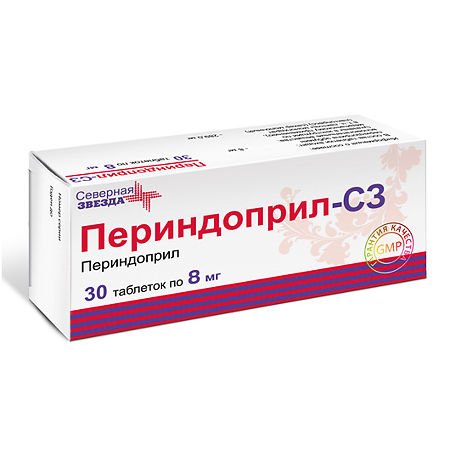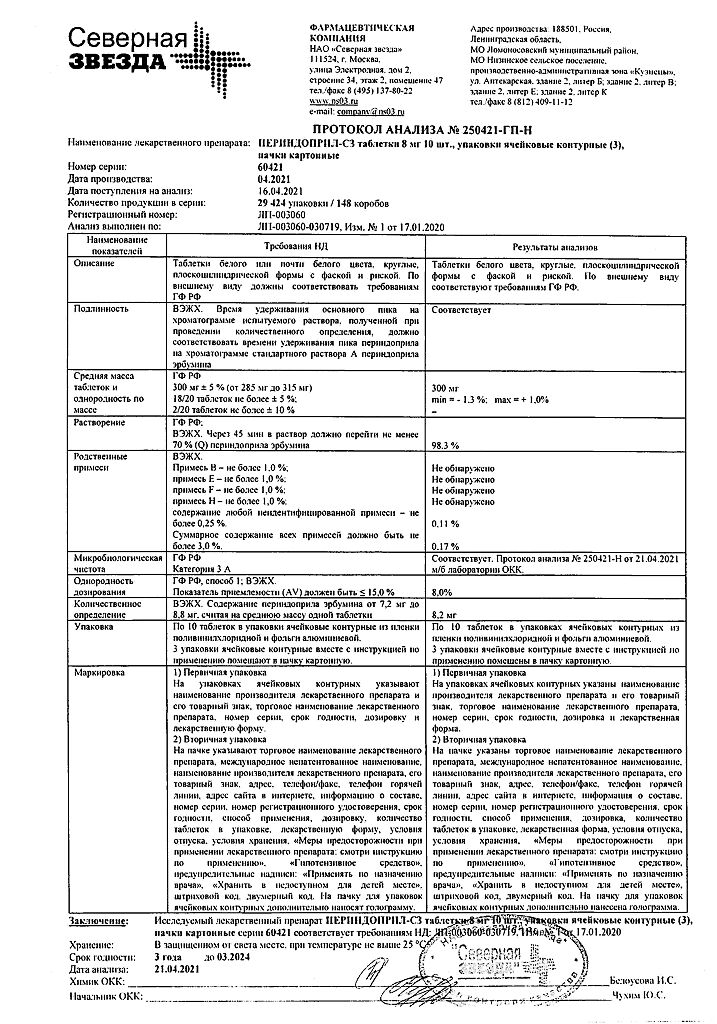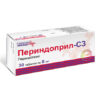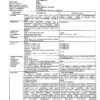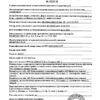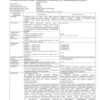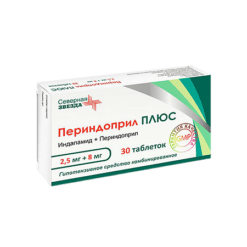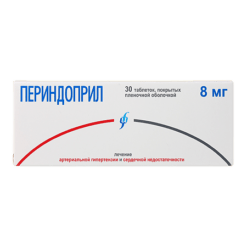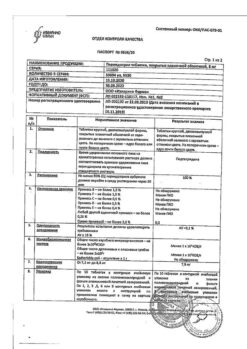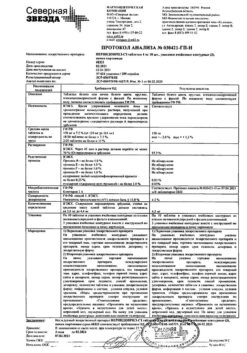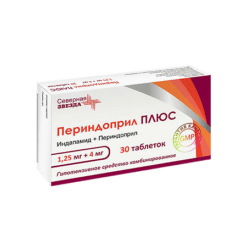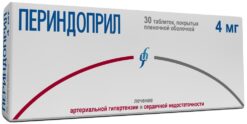No products in the cart.
Perindopril-SZ, 8 mg tablets 30 pcs
€7.56 €6.62
Description
Pharmacodynamics:
A ACE inhibitor. ACE inhibition leads to a decrease in plasma angiotensin II levels, resulting in a decrease in aldosterone secretion. Perindopril acts through its active metabolite perindoprilat. Eliminates the vasoconstrictor effect of angiotensin II, increases the concentration of bradykinin and vasodilator prostaglandins (ACE converts inactive angiotensin I into angiotensin II, which has a vasoconstrictor effect, and causes degradation of bradykinin and prostaglandin, which have vasodilator activity); reduces the production and release of aldosterone, inhibits the release of noradrenaline from sympathetic nerve fiber endings and the formation of endothelin in the vascular wall.
The decrease in angiotensin II formation is accompanied by an increase in plasma renin activity (due to inhibition of negative feedback). ACE suppression is accompanied by increased activity of both circulating and tissue kallikrein-kinin system, and the prostaglandin system is also activated.
It promotes restoration of elasticity of large arterial vessels (decrease of formation of excessive amount of subendothelial collagen), reduces pressure in pulmonary capillaries, with long-term administration reduces severity of left ventricular myocardial hypertrophy and interstitial fibrosis, normalizes myosin isoenzyme profile; it normalizes heart function.
Limits preload and postload (decreases systolic and diastolic blood pressure while lying and standing), left and right ventricular filling pressures, total peripheral vascular resistance; increases minute volume of circulation and cardiac index without changing heart rate (in patients with chronic heart failure), does not increase heart rate, increases regional blood flow in the muscles.
increases the concentration of high-density lipoproteins, in patients with hyperuricemia reduces the concentration of uric acid. Increases renal blood flow, does not change glomerular filtration rate.In patients with chronic heart failure causes significant reduction of the severity of clinical signs of heart failure, increases exercise tolerance (according to ergometer testing), does not significantly reduce blood pressure.
After oral administration of an average single dose, the maximum hypotensive effect is reached after 4-6 hours and is maintained for 24 hours. Stabilization of hypotensive effect is observed after 1 month of therapy and is maintained for a long time. Discontinuation of treatment is not accompanied by development of “withdrawal” syndrome.
Pharmacokinetics:
Absorption – 25%, bioavailability – 65-70%. Time of reaching maximum concentration in blood plasma – 1 h, perindoprilat – 3-4 h. During metabolism 20% is transformed into active metabolite – perindoprilat (taking perindopril after meals reduces the proportion of perindoprilat formed – significant clinical significance); the remaining amount – into 5 inactive compounds. T1/2 (elimination half-life) of perindopril is 1 hour.
Binding of perindoprilat with blood plasma proteins is insignificant, with ACE – less than 30% (it depends on concentration). Distribution volume of free perindoprilat is 0.2 l/kg. Perindoprilat is excreted by the kidneys, T1/2 of free metabolite fraction is 3-5 hours. Dissociation of perindoprilat bound to ACE is slow. As a consequence, the “effective” T1/2 is 25 h. Repeated administration of perindopril does not result in its cumulation, and the T1/2 of perindoprilat when repeatedly administered corresponds to its period of activity.
The excretion of perindoprilat is slower in elderly patients as well as in patients with chronic heart failure and chronic renal failure (in the latter the dose should be adjusted depending on creatinine clearance). Dialysis clearance of perindopril is 70 ml/min.
In patients with cirrhosis hepatic clearance of perindopril is decreased by half, while the total amount of perindoprilate produced does not change and dosing regimen adjustment is not required.
.
Indications
Indications
Active ingredient
Active ingredient
Composition
Composition
Composition (1 tablet):
How to take, the dosage
How to take, the dosage
Ingestion, in the morning, before meals.
The initial dose for treatment of arterial hypertension is 4 mg/day; if necessary (after 1 month) the dose may be increased to 8 mg/day in a single dose.
When ACE inhibitors are administered to patients receiving diuretic therapy, a sharp decrease in BP may be noted. To prevent this, it is recommended to discontinue diuretics 2-3 days before the intended start of therapy with Perindopril or to prescribe the drug in lower doses of 2 mg once daily.
In patients with renovascular hypertension, the initial dose is 2 mg once daily. If necessary, the dose can be subsequently increased.
In elderly patients, therapy should be started with a dose of 2 mg daily and then, if necessary, gradually increased up to a maximum dose of 8 mg daily.
The treatment of patients with heart failure in combination with a noncaliberative diuretic and/or digoxin is recommended to start under close medical supervision, Perindopril should be administered in an initial dose of 2 mg once daily, in the morning.
Thereafter, after 1-2 weeks of therapy, the dose of the drug may be increased to 4 mg once daily.
In patients with impaired renal function, the dose of the drug should be adjusted according to the degree of renal failure: depending on creatinine clearance (CK).
In case of IBC 30-60 ml/min – 2 mg once daily; in case of IBC 15-30 ml/min – 2 mg every other day; for patients on hemodialysis (IBC less than 15 ml/min) – 2 mg per day of dialysis. If the CK is more than 60 ml/min, 4 mg daily.
Patients with impaired liver function do not need dose changes of Perindopril.
.
Interaction
Interaction
Increases the severity of hypoglycemic action of insulin and sulfonylurea derivatives.
Baclofen, tricyclic antidepressants, antipsychotic drugs (neuroleptics), saluretics increase the hypotensive effect and increase the risk of orthostatic hypotension (additive effect), antacids decrease the bioavailability of ACE inhibitors.
Glucocorticosteroids, nonsteroidal anti-inflammatory drugs reduce the severity of the hypotensive effect (fluid and electrolyte retention).
Kalium-saving diuretics (spironolactone, triamterene, amiloride), potassium preparations increase the risk of hyperkalemia. Concomitant use of drugs that can cause hyperkalemia and ACE inhibitors is not recommended, except in cases of severe hypokalemia (serum potassium control).
In concomitant use with lithium preparations, its excretion from the body may be delayed (regular monitoring of lithium in the blood is necessary).
Diuretics, drugs for general anesthesia and muscle relaxants, ethanol increase the risk of excessive reduction of blood pressure.
The risk of clinically significant arterial hypotension can be reduced by stopping diuretics several days before starting treatment with Perindopril.
.
Special Instructions
Special Instructions
The risk of arterial hypotension and/or renal failure with the drug increases with significant sodium and water loss (strict salt-free diet, and/or use of diuretics, diarrhea, vomiting) or renal artery stenosis (blockade of the renin-angiotensin system in these situations may lead, especially when first taking the drug and during the first 2 weeks of treatment, to a sudden decrease of blood pressure and development of chronic renal failure).
Before and during therapy, it is recommended to determine creatinine, electrolyte and urea concentrations (within 1 month).
In patients with arterial hypertension who are already receiving therapy with diuretics, their administration should be stopped (3 days before starting Perindopril administration) and if necessary, they should be added to the treatment again.
In patients with chronic heart failure receiving therapy with diuretics, if possible, their dose should also be reduced a few days before starting.
In patients at risk, especially those with decompensated chronic heart failure, elderly patients, and patients with baseline low blood pressure, impaired renal function, or those receiving high doses of diuretics, initiation of the drug should be controlled.
In patients on hemodialysis, the use of polyacrylonitrile membranes should be avoided (anaphylactoid reactions may occur).
The administration should be discontinued 12 hours before the upcoming surgical treatment and the anesthesiologist should be warned about the use of the drug.
Impact on driving and performance of activities requiring increased attention
Due to the risk of arterial hypotension and dizziness, ACE inhibitors should be prescribed with caution to persons driving motor vehicles and engaged in activities requiring increased attention and rapid motor reaction.
Contraindications
Contraindications
Hypersensitivity to perindopril and other components of the drug or other ACE inhibitors, history of angioedema during therapy with ACE inhibitors. ACE, hereditary or idiopathic angioedema, pregnancy, lactation, age less than 18 years (efficacy and safety not established).
With caution: aortic valve stenosis, hypertrophic obstructive cardiomyopathy, cerebrovascular disease (including cerebrovascular insufficiency, coronary heart disease, coronary artery disease – risk of excessive blood pressure drop and concomitant ischemia).
Severe autoimmune systemic connective tissue diseases (including systemic lupus erythematosus, scleroderma), suppression of medullary hematopoiesis while taking immunosuppressants (increased possibility of neutropenia).
Renovascular hypertension, bilateral renal artery stenosis, artery stenosis of the single kidney, conditions after renal transplantation (risk of renal dysfunction and agranulocytosis), chronic renal failure (especially accompanied with hyperkalemia), hyperkalemia, diet with sodium restriction, conditions accompanied with decreased volume of circulating blood (including diarrhea, vomiting, diarrhea and hypertension).including diarrhea, vomiting, use of diuretics), diabetes, elderly age, surgical interventions (general anesthesia).
Side effects
Side effects
– Cardiovascular system: often – excessive decrease in blood pressure and related symptoms, rarely – arrhythmia, angina pectoris, myocardial infarction and stroke.
– Urinary system disorders: decreased renal function, acute renal failure.
– Respiratory system: often – “dry” cough, difficulty in breathing; rarely – bronchospasm, rhinorrhea.
– Digestive system: frequently – nausea, vomiting, abdominal pain, change in taste, diarrhea or constipation, dry mouth, decreased appetite, cholestatic jaundice, pancreatitis, intestinal edema.
– Central nervous system: often – headache, asthenia, increased fatigue, dizziness, tinnitus, visual disturbances, muscle cramps, paresthesias; rarely – decreased mood, insomnia; extremely rare – confusion.
Allergic reactions: common – skin rash, itching, rare – urticaria, angioedema; very rare – erythema multiforme. –
Laboratory indices: frequent – hypercreatininemia, proteinuria, hyperkalemia; hyperuricemia; rare (with prolonged use in high doses) – neutropenia, leukopenia, hypogemoglobinemia, thrombocytopenia, decreased hematocrit; Very rarely – agranulocytosis, pancytopenia, increased activity of “liver” enzymes, hyperbilirubinemia, hemolytic anemia (with glucose-6-phosphate dehydrogenase deficiency).
– Other: increased sweating, impaired sexual function.
Overdose
Overdose
Symptoms: marked decrease in blood pressure, shock, stupor, bradycardia, electrolyte disorders (hyperkalemia, hyponatremia), renal failure.
Treatment: gastric lavage, restoration of the water-electrolyte state, intravenous administration of 0.9% sodium chloride solution. In case of marked decrease of blood pressure the patient should be laid horizontally with legs raised up. Hemodialysis is effective (do not use highly permeable polyacrylonitrile membranes).
If bradycardia develops – atropine, an artificial pacemaker may be required.
Similarities
Similarities
Additional information
| Shelf life | 2 years. Do not use later than the date on the package. |
|---|---|
| Conditions of storage | List B. In a dry, light-protected place at a temperature not exceeding 25°C. |
| Manufacturer | North Star NAO, Russia |
| Medication form | pills |
| Brand | North Star NAO |
Other forms…
Related products
Buy Perindopril-SZ, 8 mg tablets 30 pcs with delivery to USA, UK, Europe and over 120 other countries.

